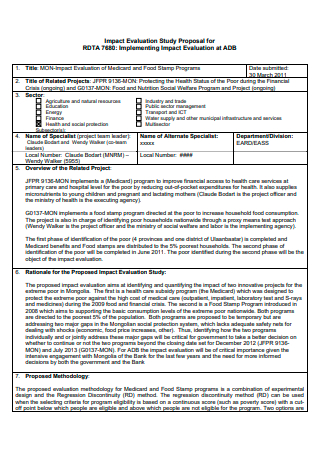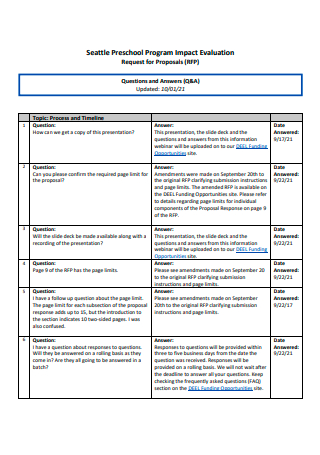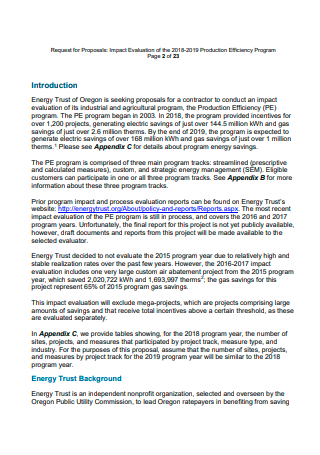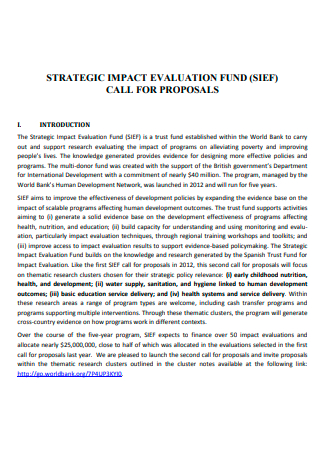8+ Sample Impact Evaluation Proposal
-

Impact Evaluation Study Proposal
download now -

Experimental Impact Evaluation Proposal
download now -

Impact Evaluation Proposal Example
download now -

Preschool Program Impact Evaluation Proposal
download now -

Impact Evaluation of Production Efficiency Program Proposal
download now -

Policy Impact Evaluation Proposal
download now -

Strategic Impact Evaluation Fund Proposal
download now -

Impact Evaluation Call For Proposal
download now -

Impact Evaluation Technical Proposal
download now
FREE Impact Evaluation Proposal s to Download
8+ Sample Impact Evaluation Proposal
What is an Impact Evaluation Proposal?
Different Types of Impact Evaluations
Basic Elements of an Impact Evaluation Proposal
How to Create an Impact Evaluation Proposal
FAQs
What are some examples of impact evaluation proposals?
What is the purpose of an impact evaluation proposal?
What are the tools used in impact evaluation?
What is the difference between impact evaluation and outcome evaluation?
What are the benefits of impact evaluation?
What is an Impact Evaluation Proposal?
An impact evaluation proposal is a concise written document that demonstrates the goals, impact evaluation questions, resource requirements and budget, structured plan of impact evaluation, evaluation tools, methodology and communication plan, and the benefits of the impact evaluation. This is a valuable tool to initiate and manage in-depth evaluation of a specific or program or project in order to develop an outline composed of suggestions, recommendations, as well as positive and/or constructive feedback concerning the status of activities, projects, program design and other elements involved in the program or project being assessed. Also, it plays an integral role in proposing to estimate unobserved counterfactual outcomes of the program or project by using a comparison group in order to measure the impact and check if it needs to be modified for further improvement.
According to a statistical report, 77% of high-performing projects use project management software. However, adoption rates for project management software remains low which is around 22% despite its impact. Also, 66% of program developers and project managers say that they would use project management software more extensively if they had sufficient support from their organization. Thus, all types of general managers, project leaders, medical and health program managers, educators, trainers, and other professionals in other fields and industries should start documenting and evaluating the impact of projects and programs every year through an effective impact evaluation proposal.
Different Types of Impact Evaluations
Due to scarce social investment resources, numerous government agencies and non-profit organizations including foundations and social investors need to provide seed capital, relax regulations or introduce pilots of targeted programs in order to promote innovation and develop programs and strategies that have clear and sustainable impacts, or that facilitate these impacts based on socially acceptable outcomes and goals. That’s why they need to conduct several impact evaluations which significantly provide sound and reliable findings which inform what drives changes and where innovations are more useful. In this section, you will learn and understand about the different types of impact evaluations. To guide you in this matter, read the following details:
1. Health Impact Assessment
The World Health Organization (WHO) stated in their website that health impact assessment (HIA) is a comprehensive and practical approach used to judge the possible health effects of a policy, programme, or project on a specific or targeted population, particularly on vulnerable or disadvantaged groups. The main purpose of this assessment or evaluation is to generate worthwhile recommendations for decision-makers and stakeholders in order to expand the positive health effects of the proposal and lower its negative health effects. Health impact assessment can be carried out in a wide array of economic sectors and utilized quantitative, qualitative and participatory techniques. Using this assessment also helps decision-makers to formulate choices about health care and medical alternatives and improvements for disease or injury prevention and for active public health promotion.
2. Environmental Impact Evaluation
Convention on Biological Diversity explained in their website the environmental impact evaluation is a process of analyzing and assessing the feasible environmental impacts of a proposed environmental project or program development, deeply considering inter-related socio-economic, cultural and human health impacts, both beneficial and adverse. It is a crucial tool to determine the environmental, social, and economic impacts of a project or program before the decision-making process. At an early stage in project planning and design, the environmental impact evaluation aims to predict environmental impacts and search for efficient ways and means to minimize adverse impacts, structure projects to suit the local environment and demonstrate the predictions and multiple options to decision-makers.
3. Social Impact Evaluation
No poverty, zero hunger, good health and well-being, quality education, clean water and sanitation, affordable and clean energy and decent work and economic growth are some examples of social impacts. Project managers and program developers use social impact evaluation to conduct various processes of analyzing, monitoring and managing the intended and unintended social consequences, both positive and negative, of planned interventions (policies, programs, plans, and projects) and many other social change processes imposed by those interventions. Social development impact evaluation is integral in order to bring about a more ecologically, socio-culturally and economically sustainable and equitable environment.
4. Equality Impact Evaluation
According to the GOV.UK website, various policies, services and legislation need to be assessed through equality impact evaluation to ensure that they don’t discriminate against anyone and promote equality of opportunity to everyone. Additionally, the equality impact evaluation is a well-designed and evidence-based tool which allows key individuals and project managers to consider the potential impact of work on different groups of people. Thus, it is used to check and analyze certain policies, practices, services and functions that don’t inadvertently disadvantage anyone, and they proactively advance equality, diversity and inclusion wherever possible.
Basic Elements of an Impact Evaluation Proposal
In this section, you will learn how to construct a remarkably written and well-designed impact evaluation proposal. However, an impact evaluation proposal has different parts. Include the following elements for you to create an excellent document:
How to Create an Impact Evaluation Proposal
Markus Frölich and Stefan Sperlich wrote in the book Impact Evaluation that the definition of parameter of interest, identification and statistical modeling are clearly separated because this helps in defining the objects one is interested in, and to clearly articulate the definition and interpretation of counterfactual outcomes. Below are some easy-to-follow tips that indicate how to design and craft a professional impact evaluation proposal:
Step 1: Write a Simple Overview of the Impact Evaluation
What are the key objectives and desired outcomes of your impact evaluation? Define the specific goals, objectives, and desired outcomes when you are conducting a comprehensive impact evaluation for your program, project or service. Include some informative details about the intended uses of the evaluation, as well as the type of evaluation that will be needed for the program, project or service. For example, write in your proposal that the impact evaluation focuses on evaluating ongoing interventions or it will be used for summative purposes.
Step 2: Explain the Impact Evaluation Tools, Resources, and Methods
How will you measure your primary objectives and other results of your impact evaluation? Describe the valid and reliable impact measurement tools, resources, and methods that you will use in your impact evaluation. Explain the impact evaluation tools and methods such as graphs, surveys, econometric and statistical tools, non-parametric methods, case studies, beneficiary assessment, contribution analysis, and many others.
Step 3: Indicate the Timeline and the Processes of the Evaluation
The timeline of the overall impact evaluation process should be properly designed and displayed in the proposal. Before the start of the impact evaluation, it is advisable that you structure an impact evaluation timeline and processes. Set clear deadlines for obtaining the results of the impact evaluation so that you are able to inform decisions about program scale-up or policy statement reforms. This will allow program developers, project managers and policy makers to plan backwards from the milestones to see whether they have adequate time to conduct the impact evaluation method that will be considered.
Step 4: Proofread and Revise the Overall Proposal
Check your proposal carefully. Write all the vital elements in your impact evaluation proposal. If you notice that you overlook some sections that require more points, we recommend that you proofread and revise the overall impact evaluation proposal.
Step 5: Prepare the Final Impact Evaluation Proposal
After proofreading and revising, you can now prepare the final impact evaluation proposal. Add some notes and other key messages you want to inform the program committee or policy management members, and/or other individuals on the last part of your impact evaluation proposal. Skim your impact evaluation proposal for final analysis and quality check.
FAQs
What are some examples of impact evaluation proposals?
Some examples of impact evaluation proposals are environmental impact evaluation proposal, grant program impact evaluation project proposal, impact evaluation request for proposal, impact evaluation project proposal, impact evaluation proposals for school, impact evaluation criteria proposal, impact evaluation proposal of business, experimental impact evaluation proposals, production efficiency impact evaluation proposal, policy impact evaluation proposal, strategic impact evaluation fund proposal, and health care impact evaluation proposal, and more.
What is the purpose of an impact evaluation proposal?
The purpose of an impact evaluation proposal is to initiate or propose an evaluation or assessment of certain effects or outcomes, whether they are intended or unintended. This will allow project managers to know and analyze whether the intervention had a beneficial effect on individuals, households, communities, and particular groups, and whether this effect can be attributed to the concerned intervention. Additionally, it helps them to gain lesson-learning and accountability.
What are the tools used in impact evaluation?
The essential tools used in impact evaluation are appreciative enquiry, beneficiary assessment, case study, causal link monitoring, contribution analysis, collaborative outcomes reporting, critical system heuristics, and democratic evaluation.
What is the difference between impact evaluation and outcome evaluation?
Impact evaluation is an assessment of the effectiveness of the project or program in fulfilling its ultimate goals, and objectives. On the other hand, outcome evaluation is a comprehensive measurement of the program effects or outcomes in the target population by utilizing the progress assessment in the outcomes or outcome objectives which the project or program must complete.
What are the benefits of impact evaluation?
The benefits of impact evaluation are to answer the question of whether the program or project is working or not, to guide in formulating decisions about scaling up, to answer questions about program or project design on which parts works and which part don’t, and provide policy-relevant information for redesign and the design of future programs and projects. Through impact evaluation, program developers and project managers are able to know why and how a program or a project works, not just if it does.
Therefore, writing a clear, and convincing impact evaluation proposal is a fundamental written document to initiate an in-depth assessment of the design, content and structure of the program or project while determining the accountability function. Impact evaluation is aligned with outcomes-based management and monitoring the contribution of development assistance towards fulfilling the development goals of the program or project. When you submit the proposal, it will provide you and other program developers and project managers an opportunity to reach the success rate of accomplishing the program management goals and objectives, and detecting specific areas of impact for overall improvement. So, here are some of our downloadable and printable impact evaluation proposal samples available in different kinds of formats such as experimental impact evaluation proposals, production efficiency impact evaluation proposals, policy impact evaluation proposals, strategic impact evaluation fund proposals, and health care impact evaluation proposals. Simply click the impact evaluation proposal templates in this article and start downloading now!
